The dramatic Steeple Jason Island in the Falklands is home to the world's largest
breeding colony of Black-browed albatross. The most recent estimate put numbers
around 440,000 - that's a lot of big birds! The colony is spread along
3 miles of coastline with numerous Rockhopper penguin pairs breeding in among
the albatross.
This is our second day in the Falklands. It begins with a pretty
sunrise and a wake-up message over the PA from
Pauline Carr quoting the often said adage, "red sky at morning, sailors take warning."
We chose the option to get up at 5am, have a cold breakfast and take
the first zodiacs to shore at 5:30 rather than sleep in and go to shore after breakfast,
as did about half of the other passengers.
Seas were a bit rougher than yesterday, but having made two zodiac landings
the day before, we know what to expect. The difficult landing
on rocks advertised by the expedition leader turned out to be a piece of cake.
I guess our kayaking and scrambling onto rocks for geocaches has made me a pro
at transferring from a small boat onto shore via rocks.
When we
leave the ship, the weather is a bit windy, but dry. By the time we arrive and
make the half mile trek to the albatross colony it is raining lightly.
Striated caracaras were out in force attacking the temporary flagpoles put out
to mark our route. As the day wore on they would stalk and attack the occasional person.
One of the culprits was tagged G33 on a leg band,
its partner in crime also had G3, but the third number was broken off.
We spot a few smaller birds to add to our
bird list including
the tussock bird, a little brown jobber that was not the least bit shy around people
and a finch with yellow coloring identified by Joe as the White-bridled finch.
We push our way through about 50 feet of tall (taller than Lynn) tussock grass
and emerge at the edge of the albatross colony. The tall grass provides
protection from the wind and rain, and we both nestle in comfortably
where we can watch the lively activity of the birds unobtrusively.
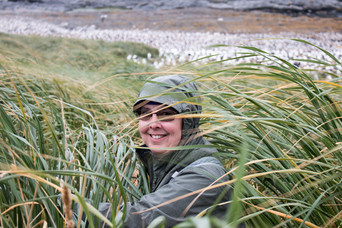
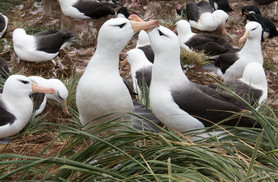
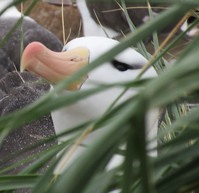
The birds are coming in LOW. VERY, VERY LOW. And they're big with
7-8 feet (200-240cm) wing spans. At the edge of the colony, they are only
a few meters away.
There are chicks in many of the nests. The adults are here
for a long time. Courting, mating, laying, hatching and fledging
take around 5 months. These guys can live for over 70 years.
There are rockhoppers in amongst the albatross.
This looks like a great spot for rockhoppers because there
are no skuas or caracara to be seen. As long as they don't
get stepped on by Black-broweds, the rockhoppers have found
a great spot.
We walked back to the landing point around 8am and donned additional warm
layers and ate some lovely hummus sandwiches. The rain was heavier
and the wind had picked up quite a bit by this time and we learned that
the planned after breakfast zodiac departures from the ship had been postponed.
This also meant we were not leaving the island any time soon.
We returned to the albatross colony for another look and hunkered down
in the tall tussock grass for another couple of hours.
At 11am, we make the trek back to the landing point and find that
a couple of boats taking people back to the ship for lunch
had already gone. A few more people had come from the ship to the island, but not that many.
Two people wanted to go back - Lynn and another woman, so Nick
took them back, intending to start a new round of shuttling
people from the boat to the island. BUT this time, the conditions
were scary rough. Lynn was the last one off the island for
many hours. Zodiac operations were put on hold.
Yes, the zodiac ride back to the ship was a bit more thrilling than I would have liked,
but Celie and I made it back and clambered up the gangway without broken limbs.
During the trip I had a death grip on the chicken rope and mostly looked
at the floor rather than the swells heading our way and washing over the zodiac.
The ship was not where we had left it in the morning, and
we learn that it is heading around to the
other side of the island to hopefully find a more favorable spot to pick up
those left behind.
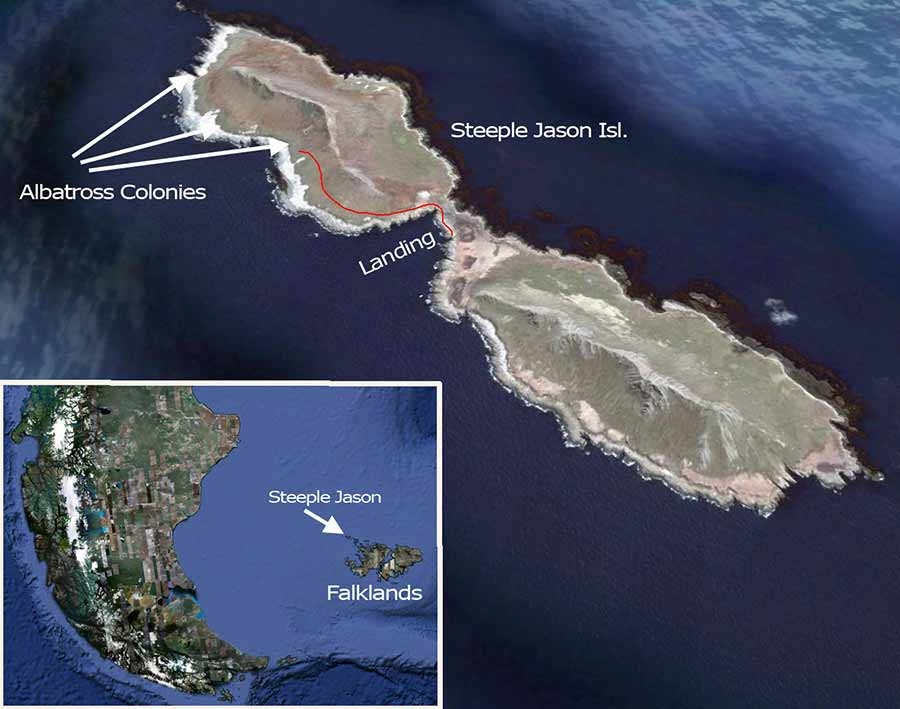
Meanwhile, back with John - stranded on Steeple Jason Island :-).
The weather was starting to clear when Lynn went back, and I
wanted to try another look at the albatross colony in good light.
I stayed, figuring I'd go back on an early "regular afternoon
return".
I headed off around the "back" of the island,
heading up toward the saddle that I thought might come over the ridge
and down onto the colony from behind. It didn't take long to get
out of sight of everyone, and to get some terrific views of the
northern coastline. The slope would have been steep to attack
head-on, but was easy to take at an angle. After fighting the wind for
a while heading toward the shoulder, I realized that if I turned around,
I could get an uphill wind assist. The rest of the climb was MUCH
easier. I sat down once before coming in sight of the landing
and the other people and appeared to have all of Steeple Jason Island to myself.
I could see a jeep track heading off along the coast, but no other
signs of human activity. Then I went up a bit higher and could look
down on the landing and the two gentoo colonies that seemed quite
large when we were down there. It was very relaxing. I could have
taken a nap, except for the caracaras, who started getting pretty
aggressive. They were hovering over and behind me and getting
bolder and bolder and more and more numerous. Up to four seemed
to be planning an attack. I decided to put on my neoprene
gloves, but I must have lost one. I only had one. That's disappointing -
they were pretty useful. Still, I ended up walking down the hill
with a gloved hand on top of my head for protection.
When I got back down I learned that Zodiac operations were still "on hold"
and the ship had left (!). But,
she was coming back - around the other side of the island, and she
was scheduled to return for a 3:30 departure.
So I poked around the nearby gentoo colonies and then went back again
to the Black-browed albatross colony. This time the weather and lighting were
nice, and there were a lot fewer people. The 3:30pm departure time came and
went and thoughts turned to the meager food supplies brought along in the morning.
We learn that tussock grass is edible.
Water is probably a bigger concern than food.
The stranded passengers are eventually retrieved shortly after dinner.
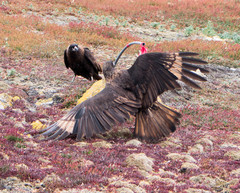
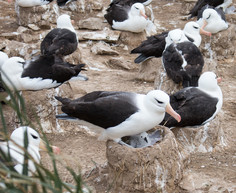
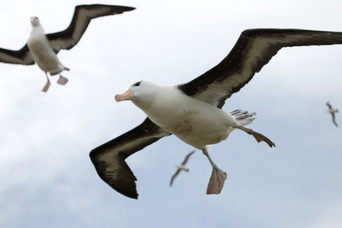
More of our Steeple Jason Island photos
|